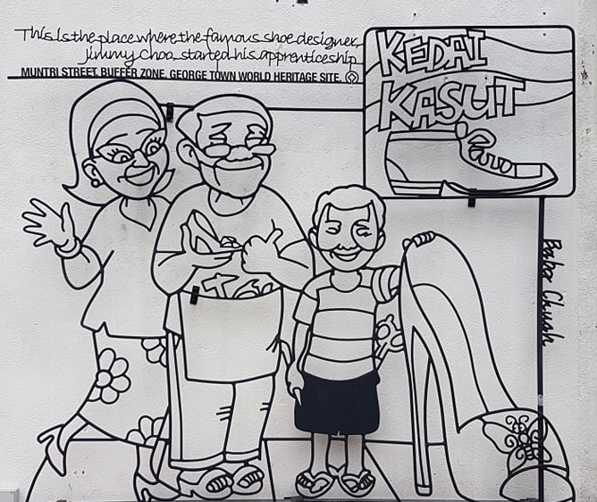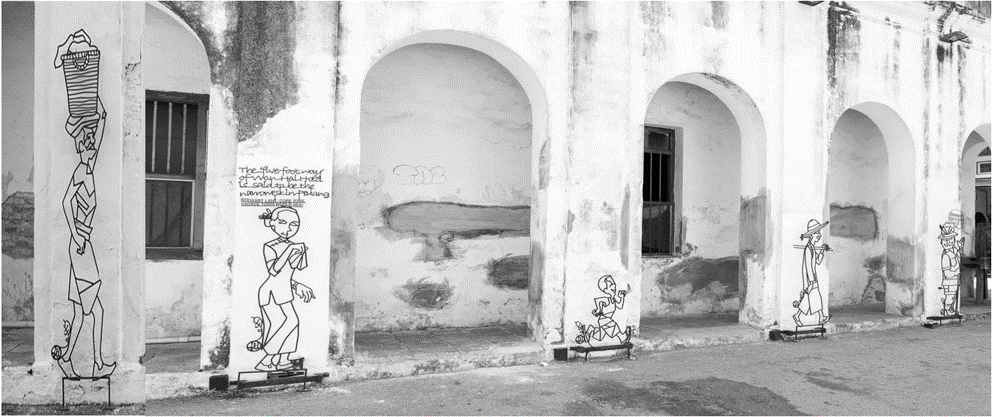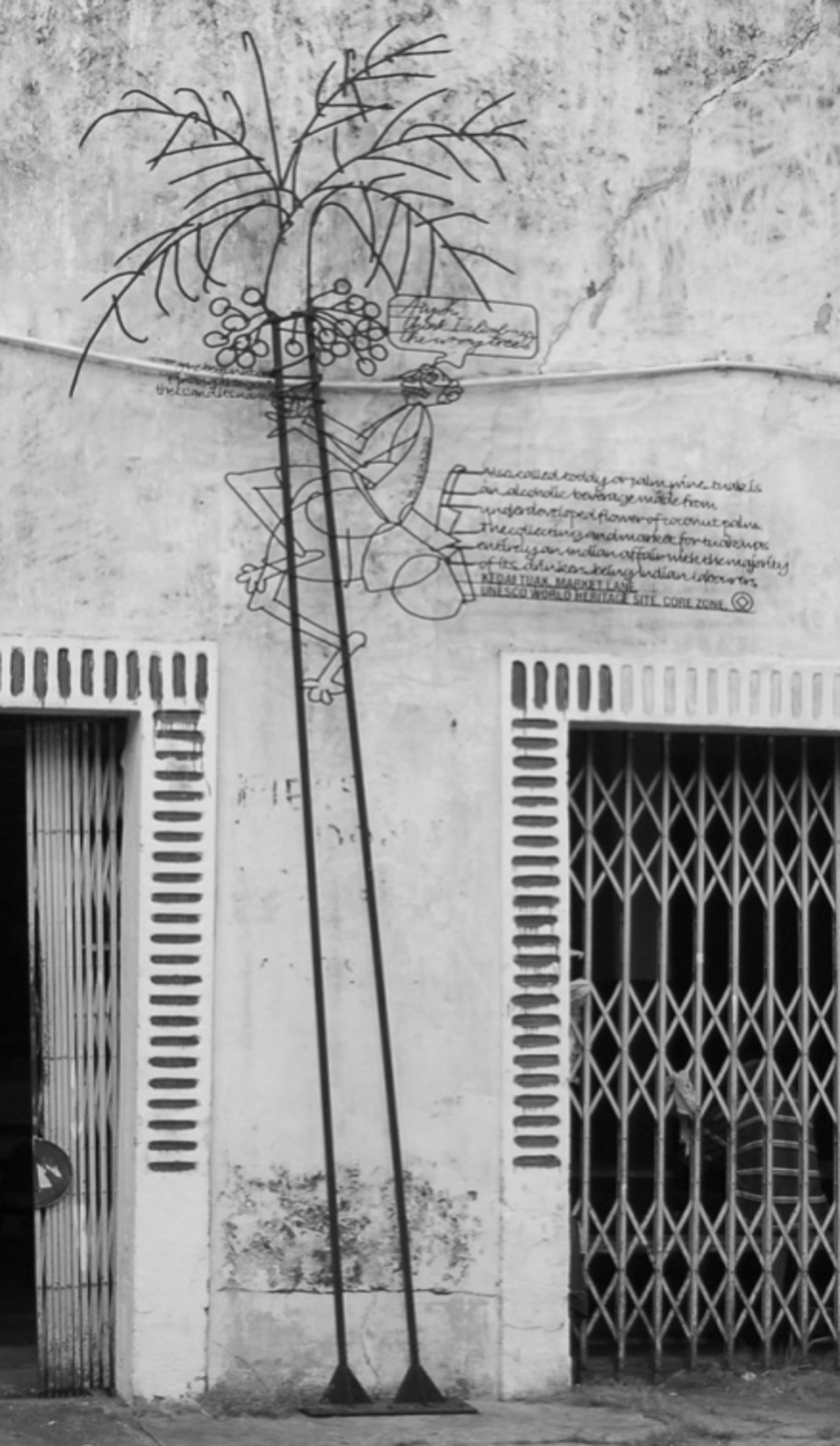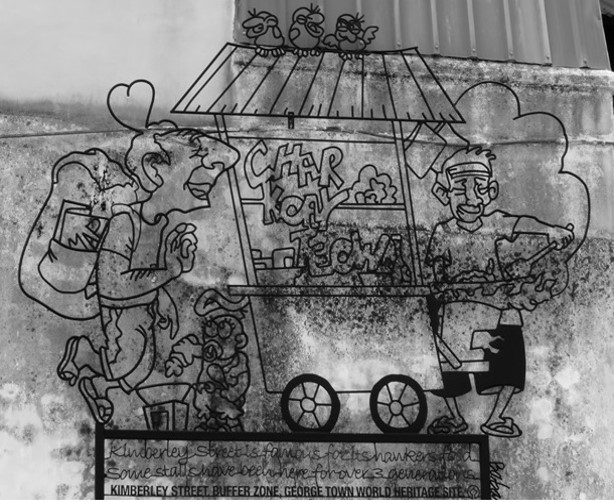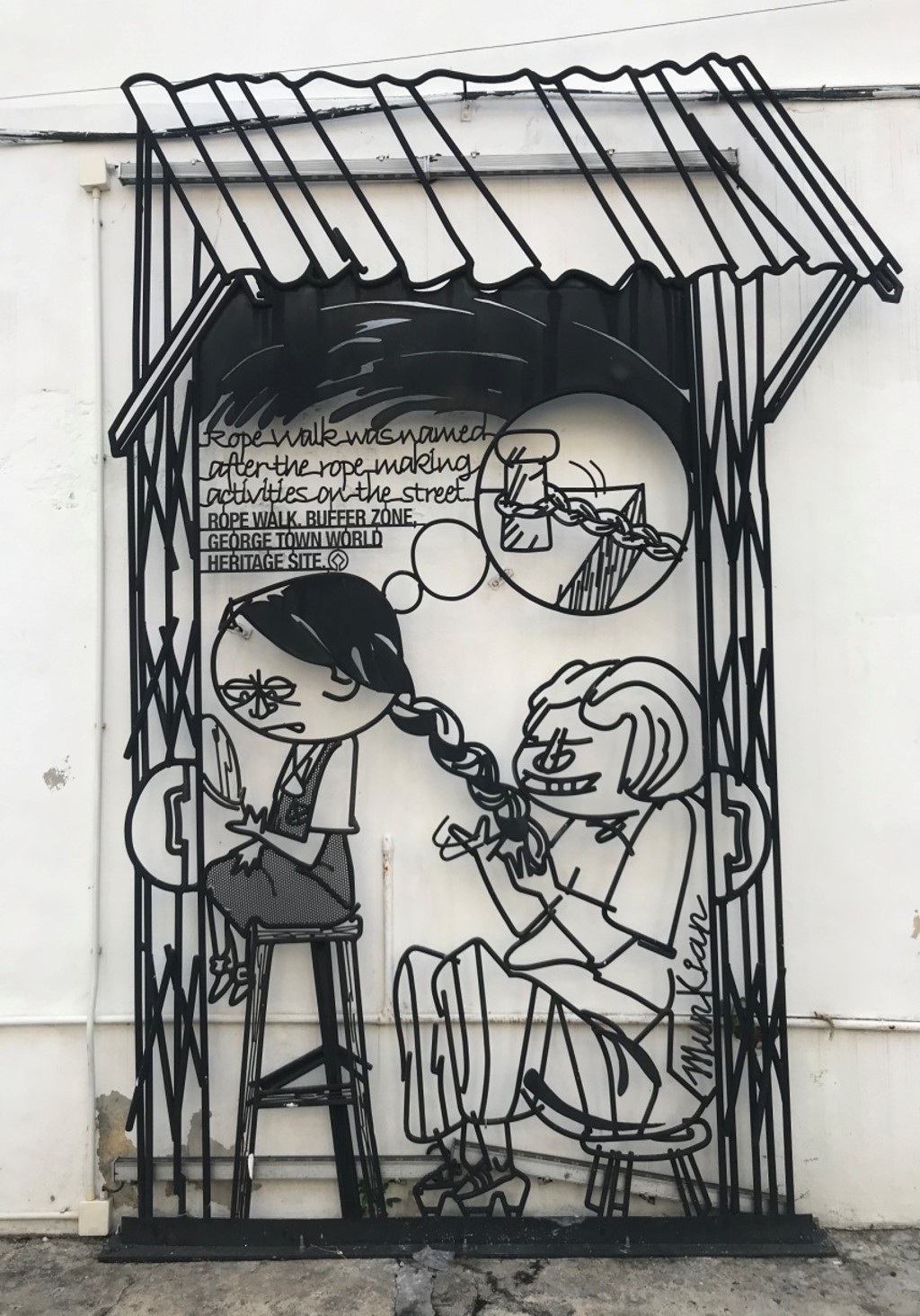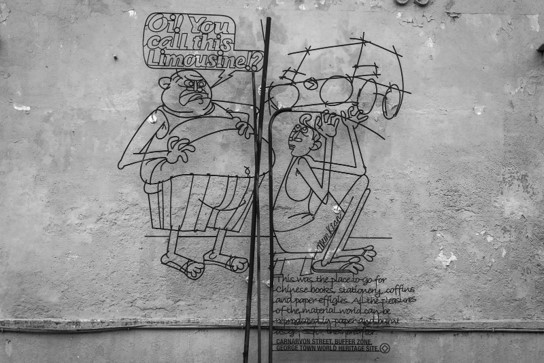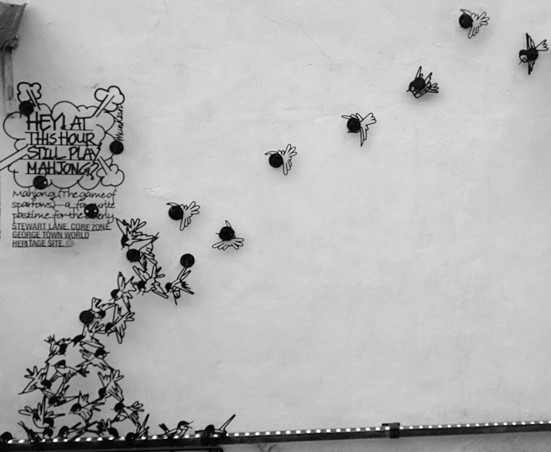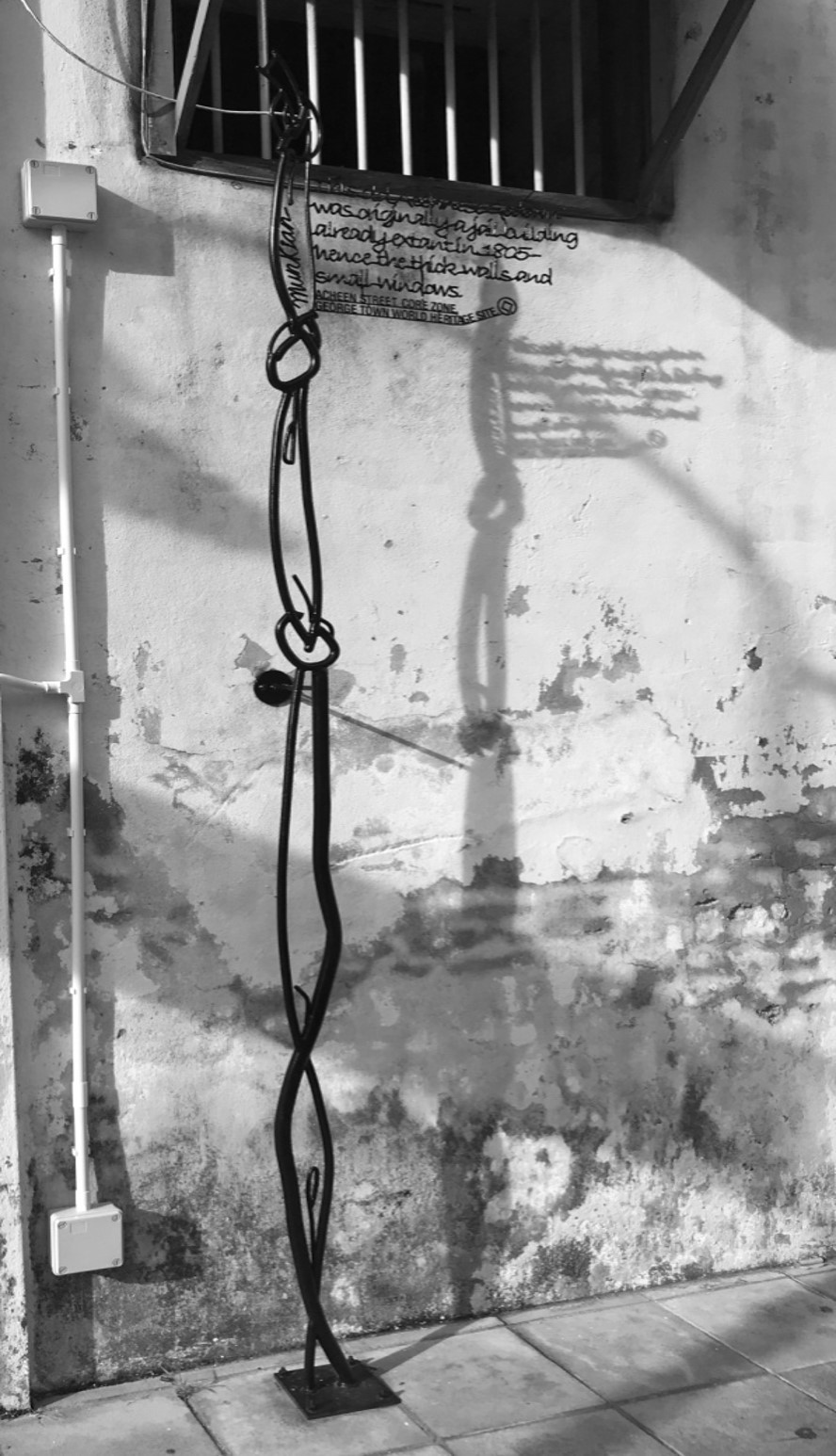Arca
-
SCULPTURE 1 : TOO SALTY
ADDRESS : NO. 32, LEBUH LIGHT

In `Too salty’, two Tamil labourers attribute their lack of hair to ingesting too much salt. Formerly, salt was important both for preserving food as well as a condiment. Sacks of salt were unloaded on jetty at the end of Jalan Green Hall then stored in its godowns.
The Tamil name for this area was Uppuvearan Teni or “Salt Traders’ Street”, a reference to the salt trading activities carried out here at this area.
-
SCULPTURE 2 : JIMMY CHOO
ADDRESS : NO. 104 LEBUH MUNTRI
-
SCULPTURE 3 : WIN-WIN SITUATION
ADDRESS : NO. 165 LEBUH MUNTRI
-
SCULPTURE 4 : MR. FIVE FOOT WAY
ADDRESS : NO. 109 JALAN HUTTON
-
SCULPTURE 5 : ONE LEG KICKS ALL
SCULPTURE 5 : ONE LEG KICKS ALL
ADDRESS : NO. 52, LORONG LOVE

An occupation that draws uni riots between rival secret societies. One of the most intriguing aspects of these riots is that both sides were multiracial, with the Muslim Red Flag association and the Hokkien Toa Peh Kong Society united against the Muslim White Flag and the Cantonese Ghee Hin.
The most serious riots broke out in August 1867 at Lebuh Cannon area. In order to put down this unrest, the alarmed colonial authorities called in reinforcements from Singapore, and cannons were fired near the site of this sculpture, leading to today`s names of Lebuh Cannon and Medan Cannon. It is said bullet holes from this time can still be found in the walls of surrounding buildings.
-
SCULPTURE 6 : BULLOCK CART WHEEL
ADDRESS : NO.101 LEBUH BISHOP
-
SCULPTURE 7 : NARROWEST FIVE FOOT WAY
ADDRESS : NO. 35 LORONG LOVE
-
SCULPTURE 8 : ROTAN
ADDRESS : NO. 37OE LEBUH CHULIA
URL: SCULPTURE 8 ROTAN
-
SCULPTURE 9 : BECA
ADDRESS : NO. 57 LORONG STEWARD
URL: SCULPTURE 9 BECA
-
SCULPTURE 10 : GOLD TEETH
ADDRESS : NO. 47 LEBUH GEREJA
-
SCULPTURE 11 : SPY
ADDRESS : NO. 34 LEBUH CINTRA
URL: SCULPTURE 11 SPY
-
SCULPTURE 12 : BUDGET HOTEL
ADDRESS : NO. 320 LEBUH CHULIA
-
SCULPTURE 13 : CHEATING HUSBAND
ADDRESS : NO. 318 LEBUH CHULIA
- SCULPTURE 14 : QUIET PLEASE
-
SCULPTURE 15 : TOO HOT
ADDRESS : GUDANG NO. 90 PENGKALAN WELD
URL: SCULPTURE 15 TOO HOT
-
SCULPTURE 16 : HIGH COUNTER
ADDRESS : NO. 313 LEBUH CHULIA
-
SCULPTURE 17 : GEDUNG RUMPIT
ADDRESS : NO. 91 LEBUH CHINA
-
SCULPTURE 18 : WRONG TREE
ADDRESS : KEDAI TUAK LORONG PASAR
- SCULPTURE 19 : UNTRAINED PARAKET
-
SCULPTURE 20 : NO MORE RED TAPE
ADDRESS : NO. 10 JALAN BURMA
-
SCULPTURE 21 : TING TING THONG
ADDRESS : NO. 235 LEBUH CHULIA
-
SCULPTURE 22 : LABOURER TO TRADER
ADDRESS : CHOWRASTA MARKET
-
SCULPTURE 23 : KOPI ‘O’
- SCULPTURE 24 : RETAIL PARADISE
-
SCULPTURE 25 : ROTI BENGGALI
ADDRESS : NO. 58 LEBUH PASAR
-
SCULPTURE 26 : MAIN STREET
ADDRESS : NO. 71A JALAN MASJID KAPITAN KELING
-
SCULPTURE 27 : SAME TASTE SAME LOOK
ADDRESS : NO. 96 LEBUH CAMPBELL
-
SCULPTURE 28 : DUCK
ADDRESS : NO. 68 LEBUH PANTAI
URL: SCULPTURE 28 DUCK
-
SCULPTURE 29 : 3 GENERATIONS
ADDRESS : NO. 143 LEBUH KIMBERLY
- SCULPTURE 30 : ROPE STYLE
-
SCULPTURE 31 : KANDAR
ADDRESS : NO. 48 LEBUH AH QUEE
URL: SCULPTURE 31 KANDAR
- SCULPTURE 32 : SHORN HAIR
-
SCULPTURE 33 : THEN & NOW
ADDRESS : NO. 89 LEBUH ARMENIAN
-
SCULPTURE 34 : AH QUEE?
ADDRESS : NO. 224 LEBUH PANTAI
-
SCULPTURE 35 : PROCESSION
ADDRESS : NO. 149 JALAN MASJID KAPITAN KELING
-
SCULPTURE 36 : LIMOUSINE
ADDRESS : NO. 153 LEBUH CARNARVON
Today, this area remains a centre both for the production of these items as well as diverse paper product, and coffins too. This sculpture shows that all of the pleasures of the material world can be reproduced on paper for burning.
-
SCULPTURE 37 : CHINGAY
ADDRESS : NO. 53 GAT JALAN PRANGIN
URL: SCULPTURE 37 CHINGAY
-
SCULPTURE 38 : MAHJONG
ADDRESS : NO. 37A LORONG STEWARD
`Mahjong’, a representative portrayal of the popular game, instead alluding to the game`s name with a flock (or `quarrelling’) of sparrows. The mahjong’s a `game of sparrows’ which favourite pastime for the elderly.
URL: SCULPTURE 38 MAHJONG
-
SCULPTURE 39 : CANNON HOLE
ADDRESS : NO. 64 LEBUH ACHEH
Trishaw riders are commemorated in two different sculptures, `Cannon Hole’ and Beca. `Cannon Hole’ marks the 1867 riots between rival secret societies. One of the most intriguing aspects of these riots is that both sides were multiracial, with the Muslim Red Flag association and the Hokkien Tua Peh Kong Society united against the Muslim White Flag and the Cantonese Ghee Hin.
The most serious riots broke out in August that year 1867 of Lebuh Cannon area. In order to put down this unrest, the alarmed colonial authorities called in reinforcements from Singapore, and cannons were fired near the site of this sculpture, leading to today`s Lebuh Cannon. It is said bullet holes from this time can still be found in the walls of surrounding buildings.
-
SCULPTURE 40 : TEMPLE DAY
ADDRESS : NO. 11 LORONG STEWARD
At the centre of `Temple Day’ is a tourist, suitably armed with a camera and copy of guidebook, surrounded by stall keepers selling a bewildering array of temple goods from incense to giant joss sticks, as seen at the stalls alongside the nearby Goddess of Mercy Temple.
-
SCULPTURE 41 : FOR YEOH ONLY
ADDRESS : YEOH KONGSI
This particular sculpture is mounted on the wall of the Yeoh Kongsi, established in 1836 as a benevolent foundation for newly arrived immigrant members of the Yeoh clan. Here we can see a line of new immigrants, each loaded down with all their possessions being scrutinised by an official `with a list’.
-
SCULPTURE 42 : TOK TOK MEE
ADDRESS : NO. 103 LEBUH CHINA
Here we see an itinerant hawker serving up bowls of wanton, or `tok tok’ mee (noodles), so called because hawkers announce their presence by tapping on a piece of hollow bamboo. The contents of a hawker`s trolley – extra bowls, the pile of uncooked noodles and a sieve – are faithfully detailed in this sculpture.
-
SCULPTURE 43 : BORN NOVELIST
ADDRESS : LORONG LUMUT
`Born Novelist is one the few sculptures to celebrate a specific person, in the case Ahmad Rashid Talu, the first to write an original Malay Novel with local setting and local characters.
-
SCULPTURE 44 : PROPERTY
ADDRESS: NO. 33 GAT LEBUH CHULIA
`Property’ celebrates the reclamation of land and the resulting building boom in new godowns and shops along the coast near Victoria Street of Weld Quay. With the pushing out this shoreline, a deep water port was created, allowing larger vessels to dock on the quayside, making loading and unloading cargoes simpler. Trans-shipment into lighters was no longer necessary.
In the background we see a junk and an Indian coolie erecting a sign, `Proposed Reclamation Project’, while in the foreground a merchant and his lawyer anticipate the profits to be made while standing on the existing jetty.
-
SCULPTURE 45 : ESCAPE
ADDRESS : NO. 322 LEBUH PANTAI
`Escape’ is confident, and bold minimalist representation showing a makeshift rope hanging from a berred window. This piece is located on a (warehouse) Gudang along Acheen Street, or the Achehnese Warehouse, one of the oldest building on Lebuh Pantai, Penang.
URL: SCULPTURE 45 ESCAPE
-
SCULPTURE 46 : IRONSMITH
ADDRESS : NO. 356 LEBUH PANTAI
`Ironsmith’ on Lorong Toh Aka telling the modern youth on the striking of the iron with still can be heard along the street where the tools to be fashiered instered of machine.
-
SCULPTURE 47 : TOO NARROW
ADDRESS : NO. 78 LEBUH ARMENIAN
The hand pulled trickshaw was the most popular former of transportation in early Penang
-
SCULPTURE 48 : COW & FISH
ADDRESS : NO. 17 LEBUH MELAYU
Cow & Fish’ is at the corner of Lorong Ikan (Fish Lane) and Lebuh Melayu. Before the extensive land reclamation. In those days this area was much closer to the sea, as well as to the Prangin Canal, making it an ideal place to land catches of fish and squid.
Land reclamation towards the end of the nineteenth century `pushed’ Lorong Ikan further inland, but many wholesalers of eggs, rice, dried fish and squid remain in this area, as tangible proof of the area`s earlier role.
-
SCULPTURE 49 : PILGRIMS
ADDRESS : NO. 18 GAT LEBUH ACHEH
`Pilgrims’ contains an expansive collection of well-observed caricatures, and captures the atmosphere as Haj pilgrims prepare to leave on their momentous journey. The standard metal rod construction is augmented by solid ship’s hull, while there is a wealth of detailing in the women’s sarongs, the assorted bundles and packages of luggage and the onlooker’s faces.
In former times Lebuh Acheh, the site of this installation, was know as a `second Jeddah’ , for Haj pilgrims from all over Malay, as well as Sumatra and Thailand converged here to join ship sailing for Mecca.
-
SCULPTURE 50 : NO PLASTIC BAG
ADDRESS: NO. 484 LEBUH PANTAI
`No Plastic Bag’ is on the wall of a shop selling the wicker baskets featured in the cartoon, and celebrates no plastic bag campaign which introduced in Penang in the year 2011.
-
SCULPTURE 51 : WATERWAY
ADDRESS : NO. 527 LEBUH PANTAI
`Waterway’ utilises a popular theme in these metal sculptures, showing a suitor wooing his sweetheart – in this case from his boat on the Prangin Canal, once a significant waterway, used for bringing goods from the dock area to the Prangin, or Sia Boey Market in those days.
We can see clearly that our suitor is a fruit vendor from the bananas and durians in his boat, and that thanks to watchful parent, his chances of romance are limited.
-
SCULPTURE 52 : DOUBLE ROLE
ADDRESS : NO. 105 LEBUH PANTAI
While Sikh are commonly associated with the police force, the earliest Sikh settle down in Penang were amongst the convicts transported from India and the Bengali sepoys, the first Sikh police officers not arriving until 1881. Some of these Sikh policemen also formed the fire brigade. The Central Fire Station, built ends, and completed in 1909 marks the beginning of a true or `dedicated’ fire service in Penang.
 MS
MS  EN
EN 
